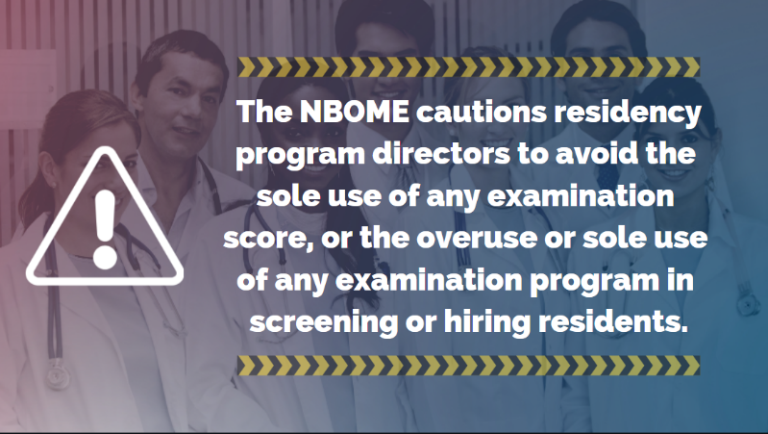Understanding COMLEX-USA
About COMLEX-USA
The Comprehensive Osteopathic Medical Licensing Examination of the United States of America (COMLEX-USA) is an evidence-based assessment series designed specifically for osteopathic medical students and residents that measures competencies required to provide safe and effective osteopathic medical care to the public.
This guide was created to assist residency and fellowship program personnel improve their understanding of COMLEX-USA, what the examination series measures, how standards are set, what candidate performance on COMLEX-USA means, and how that translates to residency performance.
Navigation
Pathway to Licensure
The primary and intended use of COMLEX-USA is for licensure, used by all medical licensing authorities to make licensing decisions for osteopathic physicians. It is accepted in all 50 United States and is recognized by the International Association of Medical Regulatory Authorities (IAMRA), as well as, by a number of other international jurisdictions1,2.
The COMLEX-USA program is designed to assess osteopathic medical knowledge, fundamental clinical skills, and other foundational competencies considered essential for the practice of osteopathic medicine.
All osteopathic medical students must pass COMLEX-USA Level 1 and Level 2-CE to graduate with a DO degree3.
DO candidates are not required to take or pass the United States Medical Licensing Examination (USMLE®) to be eligible to apply to ACGME-accredited residency or fellowship programs. The American Medical Association (AMA), the Accreditation Council for Graduate Medical Education (ACGME), and the Federation of State Medical Boards (FSMB) all recognize equivalent uses for COMLEX-USA and USMLE.
Competency & Evidence-based Design
COMLEX-USA is based on a contemporary, two decision-point, competency-based blueprint and evidence-based design informed by extensive research on osteopathic physician practice, expert consensus, and stakeholder surveys4. The enhanced COMLEX-USA blueprint assesses measurable outcomes of seven Fundamental Osteopathic Medical Competency Domains and focuses on high-frequency, high-impact health issues and clinical presentations that affect patients5,6.
Recognized Validity Evidence
COMLEX-USA is developed through a rigorous scientific process to ensure it is of the highest quality. The FSMB conducted a comprehensive review of COMLEX-USA and USMLE and found both were valid and reliable for their intended respective purposes. The FSMB concluded that support for the validity of COMLEX-USA is exemplary.
A 2020 study published by the NBOME and FSMB found the predictive validity of COMLEX-USA demonstrates a strong correlation between successful completion of COMLEX-USA and a lower likelihood of state licensing board disciplinary action. Multiple studies have reported a strong association between COMLEX-USA and USMLE scores, which can be used to predict performance on one examination from the other7,8.
Research & Score Concordance
As part of its research program, NBOME conducts studies designed to help residency program directors understand COMLEX-USA examinations with the validity evidence for using these candidate performance results or scores in holistic residency application decisions.
Most recently, NBOME published research provided concordance of scores among DO students who took both COMLEX-USA Level 1 and Level 2-CE, as well as USMLE Step 1 and Step 2-CK. The NBOME created a helpful concordance table for residency program directors to better understand the context of COMLEX-USA scores.
Resident Recruitment & Holistic Review


The medical education community recognizes the need to invest in student wellness, reduce stressors and foster inclusion for all training program applicants. To that end, a holistic admission review process in medical education considers the whole applicant, avoiding disproportionate focus on a single factor. This approach helps increase diversity in a physician population that is prepared to address varied needs across health care populations.

The Coalition for Physician Accountability’s Undergraduate Medical Education to Graduate Medical Education Transition Review Committee (UGRC)—of which the NBOME is a member—published 34 recommendations for improvement along the UME to GME transition9. These include recommendations aimed at reducing the perceived need for DO students to take a redundant exam and creating a combined score field in ERAS that allows the two exams to be easily compared, thereby mitigating structural bias.
The NBOME advocates for holistic residency screening processes that consider exam performance as just one factor of many in determining whether an applicant will perform well in residency.

Equality for COMLEX-USA & USMLE in ACGME Programs
The ACGME has aligned accreditation standards for all residency programs in the U.S., providing all graduates of medical schools (DO and MD) the ability to complete residency and fellowship training in all programs, regardless of which licensing exam(s) the individual has pursued.
The NBOME works with medical undergraduate and graduate programs along with partner osteopathic organizations on education and outreach to ensure DO applicants are considered fairly in selection processes. Many academic institutions, programs and professional organizations have updated or adopted policies that demonstrate mutual recognition and understanding of the unique qualifications and philosophies of both DO and MD graduates.
Multiple specialties have adopted consensus statements recognizing DO applicants and their COMLEX-USA credentials as part of a holistic residency application processes, including those listed below.
Over 98% of DO seniors participating in the 2023 NRMP Main Residency Match and Supplemental Offer and Acceptance Program placed into a residency program.
For more information on specialties supporting osteopathic applicants and accepting COMLEX-USA as equivalent to the USMLE:
Percentile Score Conversion
A percentile score conversion tool is accessible on our website as well as on the ERAS® Program Director Workstation. This tool converts an applicant’s 3-digit COMLEX-USA score to a percentile rank to help programs compare an applicant’s relative performance to other applicants within a testing cycle, and correctly interpret assessment scores when filtering applications.
The Percentile Score Conversion Tool is available for Level 2-CE for testing cycles. With Level 1 transitioning to pass/fail reporting as of May 10, 2022, the percentile scores for Level 1 will not be available for test cycles beginning in 2022-2023. For candidates who took Level 1 prior to May 2022 the percentile score converter provides a percentile rank for the 3-digit scores.
Interpreting COMLEX-USA Scores
Eligibility for Level 1 is granted upon completion of year one of medical study from an accredited college of osteopathic medicine AND attestation from the college that the student is in good academic and professional standing.
Eligibility for Level 2-CE is granted upon completion of second year of medical study from an accredited college of medicine; passing of Level 1; AND attestation from the college that the student is in good academic and professional standing.
NOTE: After the suspension of COMLEX-USA Level 2-PE, DO graduates in the classes of 2020-2025 must receive an attestation by their dean that indicates the resident has demonstrated the fundamental osteopathic clinical skills necessary for graduation.
Passing Levels 1 and 2-CE means a candidate has demonstrated competence to enter into supervised clinical practice settings, enter graduate medical education training, and prepare for lifelong learning.
Eligibility for Level 3 requires graduation from an accredited college of osteopathic medicine, passing Levels 1 and 2-CE, clinical skills attestation from their college or passing Level 2-PE, AND attestation from the residency program director that the resident is in good academic and professional standing. The attestation process for Level 3 helps to fulfill the NBOME mission to protect the public and adds value and entrustability to state licensing boards and patients.
The NBOME recommends that COMLEX-USA Level 3 be taken after a minimum of six months in residency.
Passing Level 3 means the candidate has demonstrated competence in foundational competency domains required for generalist physicians to deliver safe and effective osteopathic medical care of patients as required for entry into the unsupervised practice of osteopathic medicine and to continue lifelong learning and practice-based learning and improvement.
For more on COMLEX-USA eligibility, view the Bulletin of Information.

Blogs
Myths and Misconceptions: Score Concordance – What Tables (Really) Mean
A run-down of some of the myths related to score concordance and the corresponding truth.

A STRONG ASSOCIATION EXISTS BETWEEN THE SCORES ON THE COMLEX-USA AND USMLE EXAMINATIONS, ALLOWING PREDICTION OF PERFORMANCE ON USMLE FROM COMLEX-USA7. -A Concordance Study of COMLEX-USA and USMLE Scores, Journal of Graduate Medical Education, February 2022
With growing support for equivalent uses of COMLEX-USA and USMLE for residency applications, NBOME provides program directors with insight into the uses of COMLEX-USA and how COMLEX-USA scores can be an asset in a holistic resident screening and selection processes.
References
- Federation of State Medical Boards of the United States. U.S. Medical Regulatory Trends and Actions.
- International Association of Medical Regulatory Authorities: Resolution 23-1
- American Osteopathic Association. Commission on Osteopathic College Accreditation, Accreditation of Colleges of Osteopathic Medicine: COM Continuing Accreditation Standards.
- Horber D, Gimpel JR. Enhancing COMLEX-USA: Evidence-based redesign of the osteopathic medical licensure examination program. Journal of Medical Regulation. October 2018, 104(3):11-18.
- National Board of Osteopathic Medical Examiners. COMLEX-USA Blueprint effective beginning September 2018.
- National Board of Osteopathic Medical Examiners. Fundamental Osteopathic Medical Competency Domains 2016: Guidelines for Assessment for Osteopathic Medical Licensure and the Practice of Osteopathic Medicine, Chicago, IL, 2016.
- Barnum S, Craig B, Wang X, Sandella JM, Tsai TH, Boulet JR, Wang Y. A Concordance Study: COMLEX-USA and USMLE Scores. Journal of Graduate Medical Education. February 2022, 13(1): 53-59.
- Sandella JM, Gimpel JR, Smith LL, Boulet JR. The use of COMLEX-USA and USMLE for residency applicant selection. Journal of Graduate Medical Education. 2016;8(3):358-363.
- Coalition for Physician Accountability. The Coalition for Physician Accountability’s Undergraduate Medical Education-Graduate Medical Education Review Committee (UGRC): Recommendations for Comprehensive Improvement of the UME-GME Transition. August 2021.
